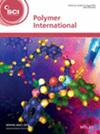求助PDF
{"title":"Synthesis of a cyclotriphosphazene derivative containing DOPO for simultaneous improvement in flame retardancy, toughness and strength of epoxy thermosets","authors":"Qiunan Xie, Ming Huang, Zhenzhen Li, Wei Hu, Jingcheng Liu, Xiaojie Li, Wei Wei","doi":"10.1002/pi.6755","DOIUrl":null,"url":null,"abstract":"<p>Improving the flame retardancy of epoxy thermosets without sacrificing mechanical properties, thermal decomposition stability and glass transition temperature (<i>T</i><sub>g</sub>) remains a challenge. In this study, a novel halogen-free flame retardant containing phosphorus/nitrogen (N<sub>3</sub>P<sub>3</sub>-DI) was synthesized from cyclotriphosphazene, <i>p</i>-hydroxybenzaldehyde, itaconic anhydride and 9,10-dihydro-9-oxa-10-phosphaphenanthrene-10-oxide (DOPO). Subsequently, N<sub>3</sub>P<sub>3</sub>-DI was used for flame-retardant modification of epoxy resin (EP). After the introduction of 10 wt% N<sub>3</sub>P<sub>3</sub>-DI, the EP thermoset achieved a limiting oxygen index of 29.6% and UL-94 V-0 rating. The peak heat release rate and total smoke production of the N<sub>3</sub>P<sub>3</sub>-DI-modified EP thermosets decreased by 48.4% and 27.5%, respectively, compared to those of the pure EP thermoset. Furthermore, the flame retardancy effect of N<sub>3</sub>P<sub>3</sub>-DI was confirmed by analysis of pyrolysis volatiles and the residual char of the thermoset. Compared with the pure EP thermoset, the N<sub>3</sub>P<sub>3</sub>-DI-modified EP thermoset also exhibited an increase of both the impact strength and flexural strength by 46.3% and 31.2%, respectively, demonstrating the effect of simultaneous toughening and strengthening. This is mainly due to the introduction of N<sub>3</sub>P<sub>3</sub>-DI reducing the crosslinking density of the thermoset network and increasing the free volume, while also improving the rigidity of the network chain. In addition, the modified EP thermosets still maintained high levels of <i>T</i><sub>g</sub> and thermal decomposition temperature. Therefore, this study provides an attractive strategy to simultaneously improve the flame retardancy, toughness and strength of epoxy thermosets, showing great prospects for future advanced applications in composites. © 2025 Society of Chemical Industry.</p>","PeriodicalId":20404,"journal":{"name":"Polymer International","volume":"74 7","pages":"611-627"},"PeriodicalIF":3.6000,"publicationDate":"2025-03-04","publicationTypes":"Journal Article","fieldsOfStudy":null,"isOpenAccess":false,"openAccessPdf":"","citationCount":"0","resultStr":null,"platform":"Semanticscholar","paperid":null,"PeriodicalName":"Polymer International","FirstCategoryId":"92","ListUrlMain":"https://scijournals.onlinelibrary.wiley.com/doi/10.1002/pi.6755","RegionNum":4,"RegionCategory":"化学","ArticlePicture":[],"TitleCN":null,"AbstractTextCN":null,"PMCID":null,"EPubDate":"","PubModel":"","JCR":"Q2","JCRName":"POLYMER SCIENCE","Score":null,"Total":0}
引用次数: 0
引用
批量引用
Abstract
Improving the flame retardancy of epoxy thermosets without sacrificing mechanical properties, thermal decomposition stability and glass transition temperature (T g ) remains a challenge. In this study, a novel halogen-free flame retardant containing phosphorus/nitrogen (N3 P3 -DI) was synthesized from cyclotriphosphazene, p -hydroxybenzaldehyde, itaconic anhydride and 9,10-dihydro-9-oxa-10-phosphaphenanthrene-10-oxide (DOPO). Subsequently, N3 P3 -DI was used for flame-retardant modification of epoxy resin (EP). After the introduction of 10 wt% N3 P3 -DI, the EP thermoset achieved a limiting oxygen index of 29.6% and UL-94 V-0 rating. The peak heat release rate and total smoke production of the N3 P3 -DI-modified EP thermosets decreased by 48.4% and 27.5%, respectively, compared to those of the pure EP thermoset. Furthermore, the flame retardancy effect of N3 P3 -DI was confirmed by analysis of pyrolysis volatiles and the residual char of the thermoset. Compared with the pure EP thermoset, the N3 P3 -DI-modified EP thermoset also exhibited an increase of both the impact strength and flexural strength by 46.3% and 31.2%, respectively, demonstrating the effect of simultaneous toughening and strengthening. This is mainly due to the introduction of N3 P3 -DI reducing the crosslinking density of the thermoset network and increasing the free volume, while also improving the rigidity of the network chain. In addition, the modified EP thermosets still maintained high levels of T g and thermal decomposition temperature. Therefore, this study provides an attractive strategy to simultaneously improve the flame retardancy, toughness and strength of epoxy thermosets, showing great prospects for future advanced applications in composites. © 2025 Society of Chemical Industry.
含DOPO的环三磷腈衍生物的合成,同时改善环氧热固性材料的阻燃性、韧性和强度
在不牺牲机械性能、热分解稳定性和玻璃化转变温度(Tg)的情况下提高环氧热固性材料的阻燃性仍然是一个挑战。以环三磷腈、对羟基苯甲醛、衣康酸酐和9,10-二氢-9-氧-10-磷菲-10-氧化物(DOPO)为原料合成了一种新型无卤磷/氮阻燃剂(N3P3-DI)。然后用N3P3-DI对环氧树脂(EP)进行阻燃改性。引入10 wt% N3P3-DI后,EP热固性材料达到了29.6%的极限氧指数和UL-94 V-0额定值。与纯EP热固性材料相比,n3p3 - di改性EP热固性材料的峰值放热率和总产烟量分别降低了48.4%和27.5%。通过对热固性材料热解挥发物和残炭的分析,证实了N3P3-DI的阻燃效果。与纯EP热固性材料相比,n3p3 - di改性EP热固性材料的冲击强度和弯曲强度分别提高了46.3%和31.2%,表现出同时增韧和强化的效果。这主要是由于N3P3-DI的引入降低了热固性网络的交联密度,增加了自由体积,同时也提高了网络链的刚性。此外,改性EP热固性材料仍保持较高的Tg和热分解温度。因此,该研究为同时提高环氧热固性材料的阻燃性、韧性和强度提供了一种有吸引力的策略,在复合材料中具有广阔的应用前景。©2025化学工业协会。
本文章由计算机程序翻译,如有差异,请以英文原文为准。




 求助内容:
求助内容: 应助结果提醒方式:
应助结果提醒方式:


